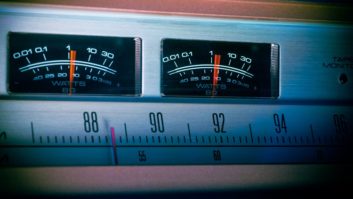Numerous readers have responded to the recent commentaries by David Bialik and Gary Keener suggesting that some FM stations or translators could benefit by broadcasting only in mono rather than stereo, and to a reply commentary in which Glynn Walden raised caution flags about that idea.
We have published some of the reactions already but here we compile them and add others.
Perception Matters
David Bialik asks, “Why stereo?” One answer: prestige.
I worked for a little FM station in northwest New Jersey decades ago that competed with the New York City stations. My station had a mono audio chain. The owners asked if I could switch the exciter to stereo just to light the stereo lamp in receivers, which I did. Dual-channel mono. They were delighted and felt they were swimming with the big dogs as an apparently stereo station.
Bialik’s point about coverage is well taken. My reception in the southern Missouri Ozarks is fringy and my car radio breaks back-and-forth between stereo and mono, with the stereo position noisy and weaker. Wish it were still a manually switchable option!
– James B. Potter, Kimberling City, Mo.
The Stereo Penalty Is Real
Gary O. Keener hit the nail on the head with “Turn Off the Stereo and See What Happens.”
The “stereo penalty” is a known engineering issue; it is real when it comes to coverage. It is a fact: FM monaural uses only 15 kHz of bandwidth while stereo uses 53 kHz. The greater the bandwidth, the more noise gets in and degrades the audio, a definite tune-out for most listeners. I’ve noticed it on all FM stations. Those most greatly affected for coverage are translators and lower-power stations.
Try it yourself with a radio that has a stereo/monaural switch. Tune around to distant stations and you’ll be convinced. You usually can’t do that on car radios, which sometimes blend to monaural in an attempt to reduce noise. That’s a nice trick but isn’t available in all radios.
Another stereo problem is in areas where there are high signal reflections, causing audio distortion and dropouts. Monaural will survive much better in those mobile environments. Try driving a troubled route. Then have someone turn the stereo pilot off before driving the same route again.
Stereo was big in the days of the Beatles and one-hit wonders of the 1960s, with some instruments in the left channel and some in the right. Today much of it is a big wall of sound with little actual stereo content, as far as I can tell. Yes, there are still some who enjoy stereo; but think of the big picture. How many listeners do you get each way?
The hype about FM stereo is lost on most listeners today. They want clean audio and will tune away when it isn’t.
– Mark Persons, CPBE, W0MH
And Then There’s Quad
I read Gary Keener’s comments about turning off the stereo on FM. First off, no offense but are you crazy?
How far back does radio have to go?
Stereo adds “spatial-ness” to the music. My whole car comes alive listening to the Beatles in stereo even on the satellite radio. At a distance from a station, radios blend the stereo so much you don’t need to turn off stereo. Even on talk radio sound effects can be fun.
I wish AM stereo had still big. And HD Radio is great in my book. But my book never was published. And then there’s quad …
– Terry Wallace
[Check Out More Letters at Radio World’s Reader’s Forum Section]
Take Me to The Pilot
Gary Keener’s article clearly suggests the advantage of an FM station operating in mono.
In the past, though, we learned that some FM receivers will mute without a stereo pilot. Something to think about if you are considering this mode.
– Bill Ruck, San Francisco
Save the Foot, Lose the Patient?
Interesting articles that point out how we’ve technically messed up a most worthwhile medium.
In many cases the listener is hearing the station in a vehicle that’s built with four or more speakers. Separation on FM tuners is affected by the distance from the transmitter, and many stations’ stereo signal is “blended” as the pilot carrier loses strength. My 2018 Toyota Camry has a pretty good FM tuner including HD, but the “Stereo” indicator is missing. Prior tuners indeed showed whether a stereo signal was being received or not.
In 1982 we installed AM stereo on WKRC in Cincinnati. The signal was fed through an Orban stereo synthesizer to minimize the artifacts that the Kahn AM stereo provided. Few of our listeners could hear the stereo, and few could see that the “light” was turned on. But it was a good indication that we had gone the extra mile.
I’d suggest that if a station operator with a lesser signal wanted to minimize the noise in fringe areas, they keep the stereo pilot on while providing two identical channels. There are still tuners out there that rely on that stereo signal to even activate audio. Otherwise it sounds like a dead signal — or would even be bypassed by scanning circuitry.
Most music created these days has very little discrete left and right information, unlike the original stereo version of “Meet The Beatles” with music in one channel and vocals in the other.
But the other school might suggest putting out the best stereo signal for the majority of the audience receiving a robust quality signal. It may affect the fringe listener, but keeping the core listener satisfied is a great way to keep your business running smoothly.
Granted, it’s tough to keep everyone happy; but turning off stereo might be akin to saving a patient’s foot while losing the patient.
Thanks to Gary for the suggestion. It’s a worthy experiment.
– Dave Mason
The Idea In Practice
Thanks for publishing the Keener letter on translators in mono. I have been suggesting this to my brokerage and consulting clients for years, especially the spoken-word ones. Heck, one of my full-power stations is doing this.
The usual multiplex noise is perceived as weak signal. With that gone, even the 48 dBu is a solid and listenable signal.
I’ve also read what Mr. Walden wrote and I still stand by my comments. Regardless of what I’m driving, my new Jeep or old Jaguar, or when listening on a portable radio, dropping the stereo eliminates a lot of the problems association with stereo. Sure, the signal strength is still present either way, but the mono is perceived as being stronger due to the lack of noise. Also, commercials on spoken-word stations usually have no music beds. Three of my FMs are in mono and I have not had one person comment on it.
– Jonathon R. Yinger, President/CEO, The Christian Broadcasting System. Ltd. and Broadcast Properties LLC
Blasting Seattle
I am reminded of the operation of CKO-FM 4 in Vancouver, which was part of the short-lived Canadian All News Network.
The transmitter site was on or near Mt. Seymour, with very high HAAT to the south. In mono, it was fed from eastern Canada on a circuit that appeared to roll off at 8 kHz or so. In downtown Seattle, and lots of other places in “multipath city,” it was by far the hottest audio signal on the FM band.
Years ago I tried to convince a friend and client who owned a couple of “beautiful music” stations to turn off the stereo, since most of his audiences were in environments where the radio was really just there for background. But he was a pretty good “seat of the pants” engineer and he’d been an FM pioneer; he couldn’t give up on the technical allure of FM stereo.
– Benjamin F. Dawson III, P.E., Hatfield & Dawson Consulting Engineers, Seattle
In-Car Clarification
Gary Keener wrote that “about 70 percent of OTA listening is currently in vehicles.” Please pass along that he is not reporting the percentage of in-car listening correctly.
Nielsen in the Q4 2021 “Audio Today” report notes that 65% of listening is out of home. Of that out-of-home portion, 70% is in-car. So the numbers are 35% at home, 46% in-car and 19% work/other.
I understand that his point is about when to use mono FM to extend the “enjoyable” listening range on smaller stations. Good comments.
– Brent Lightfoot, Vice President, Research, iHeartMedia — Markets Division, Myrtle Beach, S.C.
Don’t Forget the Other Benefits
Gary Keener wrote: “With stereo, that means noise in the fringe area. Without stereo, you can get it without noticeable noise a lot further out. … This is a psychoacoustic fact about radio. Noise equals ‘Gee, what else is on?’”
I can absolutely hear stereo in my car — maybe not a 3D soundstage, but definitely left and right separation. And with HD Radio, the stereo separation and higher frequencies sound even clearer.
But point made about fringe reception, because in rough areas, as the car goes in between HD Radio and not, there’s a momentary silence as it shifts. To get around that, I turn off HD Radio and just listen to stereo, which seamlessly shifts between stereo and mono in the car as needed.
Home stereos must be “told” manually to operate in stereo or mono, so they’ll deliver a scratchy stereo signal from a community radio station all day long. But car stereos automatically switch to mono as it starts to get scratchy. I don’t know the method or the threshold.
While the broadcaster can indeed broadcast in stereo to deliver those benefits on purpose, let’s not discount the stereo listener, RDS and even HD Radio in the immediate vicinity of a broadcast station.
– Anthony Burokas, CEO, IEBA Communications, Frisco, Texas
Talk In Stereo
One fact not considered in the commentary “Turn Off the Stereo and See What Happens” is that the search function of many receivers will not stop on a mono signal. They have to see a stereo pilot to consider the station “listenable.” Therefore, when transmitting in mono, you may be losing listeners by being “skipped over.”
Also, most current receivers have a progressive mono blend or other similar functions that eliminate separation (and noise) on weaker signals.
Most RBDS encoders require a 19 kHz pilot to sync to, or they will not provide output. In this case, running mono will prevent you from using RBDS.
In view of the above, I run all my talk and mono stations in stereo with no apparent degradation in coverage.
– Rod Rogers, Rogers Engineering, Salina, Kan.
Only in Emergencies
Mono on FM? Only in an emergency, in my opinion.
We have a mono output on our board that goes to the transmitter room just in case we need it. Our stereo feed is our primary signal source to AM and FM. Although our AM is in mono we use a small mixer to combine left and right.
When I returned to KRFE after so many years I found out that previous engineers told management that “talk radio doesn’t need stereo because no one will notice.” Even the stream audio was a left channel sample split to left and right stream! I also couldn’t find a lot of equipment that was on the old station inventory lists. Maybe our stereo equipment found better use in other stations?
Our network shows are in glorious stereo so we will utilize it to the fullest and yes, you can tell a difference. Dana Loesch sounds remarkable in proper stereo.
Technology isn’t an issue with us as long as our listeners are happy. And stereo talk radio sounds great in vehicles and in homes.
– Kerns Garza, Chief Operator, KRFE Radio, Lubbock, Texas
Mono Has Its Place
I agree with everything Glynn Walden explained in his article “Mono on FM: Hang on a Moment.”
In-car listening has been greatly improved over the years, with DSP and other techniques to improve the listening experience, and operating in mono is not a huge improvement for many situations.
I’m a big proponent of mono transmission for low-power stations or spoken word. It makes a huge difference in non-mobile receiving environments.
Office and home audio systems, portable radios and the like have their limitations. I’ve observed that listening to lower-powered stations (or full-power stations outside the 70 dBu contour) in residential and commercial environments can be a noisy experience; the receiver could be decoding full stereo even with noise –20 dB below the decoded audio. Many radios have automatic switching with no manual override for mono, and there are other situations where the user is unaware of the improvement mono can provide.
Those who have chosen to broadcast in mono likely have many experiences where they felt powerless about local noise, so they made the conscious decision to force the issue and provide the best experience possible for the greatest number of listeners by using mono.
So far, with three music translators, I’ve received only one call about not broadcasting in stereo. I’ve also found that many radios don’t even have a stereo light, so who’s to know which mode the station is in?
One compromise: The Omnia 9 audio processor, a wonderful toolbox of audio innovation, has a feature that is useful for just this situation, called Auto Pilot. This feature detects speech and low L–R to automatically switch off the pilot. I see this as a reasonable option for those who want music in stereo (which will mask the noise) and speech in mono.
– Andrew Armstrong , Chief Engineer and IT Manager, Portland Radio Group
A Final Word
I truly enjoyed reading Gary Keener’s commentary this morning. Of course, the fact that I agree with him made it even more enjoyable.
I think having guest commentaries such as Gary’s adds depth and widens the horizon of Radio World. It’s a great idea.
– Larry Cohen, Utica, N.Y.
Radio World invites industry-oriented commentaries and responses. Send to Radio World.












